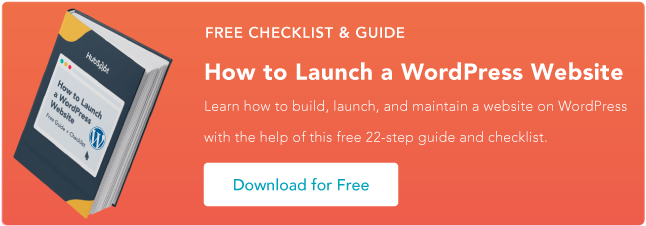Let’s look at the six most common WordPress challenges and how you can conquer them.
1. Security Vulnerabilities
A successful cyberattack on your website is just about the worst thing that can happen to your online business. You’ll lose customer trust, spend time and money on cleanup, and land in legal trouble if private data is leaked or stolen.
Unfortunately, security issues are a reality of using WordPress and probably the most important aspect of your website to take care of pre- and post-launch. WordPress websites are a popular target for hackers for a few reasons:
- WordPress is open-source, meaning all of its core code files, as well as plugins and theme files, are available for anyone to view and find security loopholes.
- WordPress is popular with beginner website owners who often lack an understanding of cybersecurity. Hackers know this and target their websites accordingly.
- Most WordPress add-ons are developed by third parties. The lack of quality control has led to themes and plugins with security vulnerabilities.
The WordPress CMS itself is actually quite secure on its own, as the WordPress development team is diligent about finding and patching security problems.
Instead, hackers tend to target websites with (1) outdated WordPress installations and/or (2) exploitable plugins and themes. This means that websites that haven’t been updated in a long time, as well as websites with poorly coded themes or plugins installed on them, are particularly vulnerable.
What you can do: To protect your WordPress website from security threats, there are a few best practices you should follow:
- Always keep your WordPress installation up to date, either manually or automatically. This sounds easy, but, according to Sucuri, more than half of WordPress installations were not up to date in 2021.

- Only install well-vetted plugins and themes from reputable sources, and keep these plugins and themes updated. Check to see if there are any known security issues before activating them on your site.
- Install a WordPress security plugin like Wordfence or Sucuri. These plugins will help to secure your website and protect it from hackers.
- For logins, choose a username besides “admin” and use strong passwords. Update your password occasionally, and consider two-factor authentication as well.
- Always have SSL/TLS encryption enabled on your website.
By taking these simple precautions, you can help keep your WordPress site secure. For more ways to protect your visitors, check out 20 Steps to Secure Your WordPress Site.
2. Slow Performance
Another common issue new WordPress site owners face is poor website performance — in other words, slow loading times.
We all know how frustrating a slow website can be. It’s an industry-wide belief that if users need to wait longer than three to five seconds for their content to load, they’ll become frustrated, even on mobile devices. A good chunk of visitors will likely leave your website for a competitor, especially if it's their first time on your site.
Plus, loading time on both desktop and mobile is a known Google ranking factor. This means that faster websites are more likely to rank higher in results on Google (and probably other search engines, too). The flip side to this is that slower websites are punished by being pushed down in search results — not a place you want to be.
WordPress is notorious for being slow, and the usual culprits are poorly coded plugins, an excessive number of installed plugins, inefficient hosting, or a content database bloated with unused files. All of these factors reduce your site’s ability to handle traffic, especially over slower internet connections.
What you can do: Not sure if your WordPress website performs well? First, run your site through a free website speed checker like Website Grader. A tool like this will tell you if your site is fast enough to retain visitors and offer some more tips on how to improve.
.webp?width=650&height=333&name=6%20WordPress%20Challenges%20How%20to%20Overcome%20Them%20and%20Build%20a%20Better%20Website%20(1).webp)
Then, for WordPress sites specifically, we have a guide of steps you can take to speed up your WordPress site (there are 25 of them) — be sure to give that a read if you’re not happy with your site’s performance.
In some cases, simply switching to faster WordPress hosting can make a world of difference. Another easy way is to install a caching plugin, which will save copies of your pages and posts so that they can be loaded more quickly. Other options include reducing the number of plugins you're using or using a WordPress content delivery network (CDN).
With a little elbow grease, you can get your WordPress website loading more quickly, and your visitors will thank you for it with more conversions.
3. Do-It-Yourself Product
These days, many website builders allow you to simply sign up, tweak some visuals, add content, and launch your site — and the platform handles the rest. WordPress is not one of these platforms.
The WordPress CMS is actually a very stripped-back product with relatively limited features. The real benefit of WordPress comes from its customizability, allowing you to tack on whichever themes and plugins you want.
However, this puts a lot of responsibility on the website owner. It’s on you to not only add content and design their website, but also to manage their site’s back-end functionality. This includes finding plugins for marketing, analytics, SEO, security, and page builders, as well as a workable theme and adequate hosting.
To sum up, you may not need to know how to code in order to use WordPress, but there’s still a good amount of work involved if you want anything beyond a basic publishing site.
What you can do: This one has less of a clear-cut fix and is more just a reality of working with WordPress. If you want a quality WordPress website for cheap, you’ll need to invest more of your time to get it.
Of course, there are WordPress alternatives that do more of the heavy-lifting and may better suit your needs. Content Hub offers powerful marketing tools, built-in security features, and hosting included. Best of all, you can get started for free.
4. Overreliance on Plugins
Speaking of plugins, there are nearly 60,000 free and premium WordPress plugins available to use. This (understandably) may tempt you to install dozens of plugins to handle every possible function on your site.
While plugins are invaluable to WordPress, they can also cause problems if not used correctly. First off, plugins are one of the most common security vulnerabilities on WordPress websites. Poorly written and outdated plugins are a hacker’s way into your website, and the more plugins you have installed, the greater the chance one of those plugins is susceptible to attacks.
Too many plugins can also slow down your website, since your web server is doing more work to run all of these plugins at once. Even if a plugin appears to do one simple task, it can drain server resources if poorly designed.
Lastly, an excess of plugins may cause compatibility issues. When you install a new plugin, you may find it breaks your site because it conflicts with your theme, WordPress version, or another plugin.
What you can do: It’s important to find a balance when using plugins and only use those that are absolutely necessary to run your site. Before installing a new theme or plugin, always check to see if it is compatible with your current setup on a staging site.
It also doesn’t hurt to occasionally review your plugins and uninstall any that you no longer need.
5. Confusing Errors
Error messages are a part of life when running any website, but WordPress throws some particularly notorious ones that may scare off new site owners. And, unless you pay for premium support from your hosting provider, it’s unlikely you’ll be able to speak to someone to help get your problem fixed.
One of the most common WordPress errors is the white screen of death. A little dramatic of a name, sure, but any downtime on a website can have downstream effects on conversions and sales. This error can be caused by many things, including a plugin or theme conflict, an issue with your hosting server, or a corrupt database.

Other common errors include issues with memory limits, internal server errors, and connection timeouts. Often, WordPress will tell you what the error is, but not the source of the problem or how to resolve it.
What you can do: Be ready to encounter at least a couple of errors when setting up your website. They’re annoying, but can almost always be resolved. The good news is that nearly any error you encounter has been dealt with before, and you can search online for answers and troubleshooting guides.
6. Unexpected Costs
Hold on — isn’t WordPress free?
Technically, yes, the WordPress CMS software is free for anyone to download and use. However, there are costs to using the platform that you may not anticipate if you want a 100% free experience.
Here are some costs you can expect to pay to launch and maintain a WordPress site:
- domain name
- hosting
- premium themes and plugins
- designer/developer costs
- security protections
The amount you can expect to pay for a WordPress site depends on how much you’re willing to invest in paid features. For instance, you could pay very little (like $3 per month little) for shared WordPress hosting, but you’ll want to invest in VPS hosting, cloud hosting, or dedicated server hosting as your traffic grows. Otherwise, your site’s performance will suffer.
For a more in-depth breakdown of WordPress costs, check out our guide: How Much Does a WordPress Website Cost?
What you can do: This one’s pretty straightforward. While “free” is a major draw of the WordPress platform, know that you’ll have to open your wallet at some point.
Is WordPress worth the challenges?
The truth is, there’s no such thing as a perfect software tool. There will always be drawbacks and trade-offs, no matter which site builder or CMS you pick for your online business.
Despite its challenges, WordPress remains king of CMS platforms, and for a good reason — it’s cheap, intuitive, accessible, and user-friendly. Plus, most of these issues we’ve covered are entirely preventable, as long as you know what to do when you run into them.
WordPress Website



![How to become a WordPress developer [+ tips from WCEU speaker Paul Bearne]](https://53.fs1.hubspotusercontent-na1.net/hubfs/53/59_How%20to%20Become%20a%20WordPress%20Developer.png)








